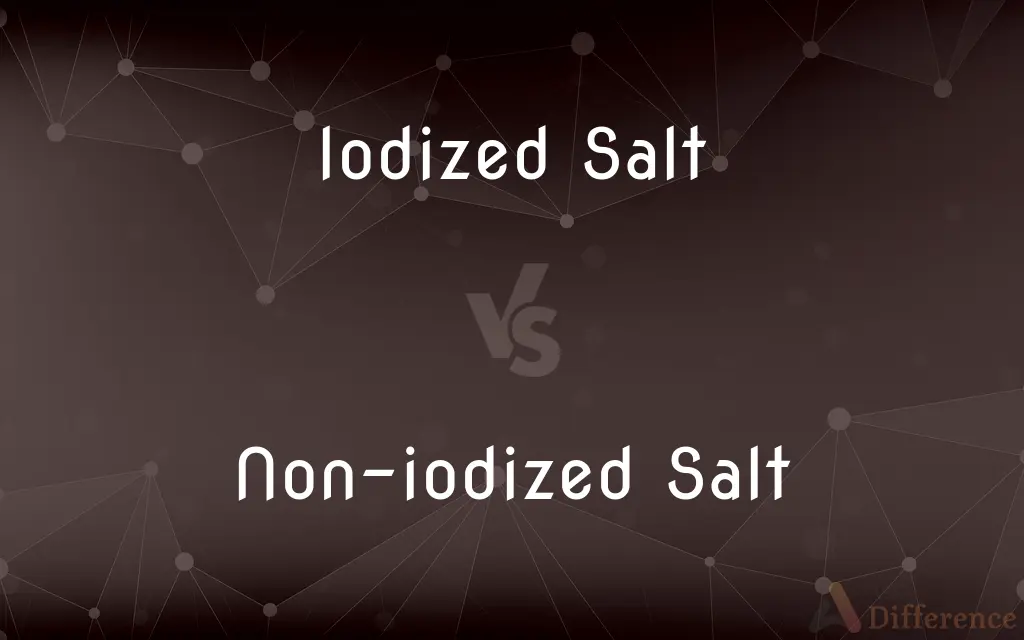Iodized Salt vs. Non-iodized Salt — What's the Difference?
Edited by Tayyaba Rehman — By Fiza Rafique — Published on November 1, 2023
Iodized Salt is table salt with added iodine essential for health, while Non-iodized Salt lacks this crucial nutrient.

Difference Between Iodized Salt and Non-iodized Salt
Table of Contents
ADVERTISEMENT
Key Differences
Iodized Salt, a staple in many households, contains added iodine, an essential nutrient that plays a pivotal role in thyroid health and metabolic functions. Non-iodized Salt, on the other hand, is simply salt that hasn't been fortified with iodine, and is commonly used in various culinary applications and processes where the presence of iodine might alter the chemical reaction or the taste.
The iodine in Iodized Salt is vital in preventing iodine deficiency, a serious health issue that can cause conditions such as goiter and developmental problems in children. Conversely, Non-iodized Salt does not offer these protective health benefits, but it's preferred in certain food preparations and preservation methods, as iodine can sometimes interfere with fermentation processes or the flavor of pickled foods.
Iodized Salt became popular due to public health policies aimed at addressing widespread iodine deficiencies; its taste is virtually indistinguishable from Non-iodized Salt for most palates. However, some gourmet salts, often Non-iodized, are praised for their unique flavors, textures, or mineral content and are used to enhance the culinary experience.
In some regions, people have a preference or dietary need for Non-iodized Salt, possibly due to medical conditions that require them to monitor their iodine intake. However, for the general population, Iodized Salt is usually recommended by health professionals because of its role in maintaining thyroid health.
It's important to note that both Iodized Salt and Non-iodized Salt contain the same amount of sodium, and excessive consumption of either type can contribute to health issues like high blood pressure and heart conditions. The choice between the two should consider both culinary goals and nutritional needs.
ADVERTISEMENT
Comparison Chart
Iodine Content
Contains iodine
Does not contain iodine
Health Benefits
Prevents iodine deficiency
Lacks iodine-related benefits
Taste
Almost indistinguishable to most
Preferred for some culinary uses
Culinary Applications
General cooking
Specific processes (e.g., pickling)
Health Recommendations
Recommended for general population
Used for specific dietary needs
Compare with Definitions
Iodized Salt
Has no significant taste difference."
He couldn't taste the difference with Iodized Salt in the recipe.
Non-iodized Salt
Preferred for certain medical conditions."
His diet, due to thyroid issues, consisted of Non-iodized Salt.
Iodized Salt
Table salt fortified with iodine."
She always purchased Iodized Salt for its health benefits.
Non-iodized Salt
Chosen for specific culinary applications."
The chef used Non-iodized Salt in the fermented dishes.
Iodized Salt
A public health measure."
Iodized Salt was introduced to eradicate goiter in the region.
Non-iodized Salt
Lacks the health benefits of iodine."
Non-iodized Salt doesn't help in preventing iodine deficiencies.
Iodized Salt
Essential for thyroid health."
Iodized Salt is a staple in her diet for metabolic balance.
Non-iodized Salt
Has a consistent flavor profile."
She preferred the reliable taste of Non-iodized Salt for her dishes.
Iodized Salt
Crucial for preventing iodine deficiency."
The doctor recommended Iodized Salt to avoid thyroid issues.
Non-iodized Salt
Pure salt without added iodine."
For pickling, he used Non-iodized Salt for the best results.
Common Curiosities
Can you use Non-iodized Salt instead of Iodized Salt for cooking?
Yes, Non-iodized Salt can be used in place of Iodized Salt in recipes, but you'll miss out on the iodine benefits.
Can I use Non-iodized Salt in a salt shaker?
Absolutely, Non-iodized Salt can be used just like Iodized Salt for seasoning.
What are the health risks of using Non-iodized Salt?
The main risk is potential iodine deficiency if not obtained from other dietary sources.
Why use Non-iodized Salt in pickling?
Non-iodized Salt is used in pickling because iodine can interfere with the fermentation process and affect the flavor.
Is Iodized Salt more expensive than Non-iodized Salt?
Not significantly; any price difference is usually minimal.
Is sea salt Iodized Salt?
Not usually. Most sea salt is non-iodized, though there are exceptions.
Is Iodized Salt better for your health than Non-iodized Salt?
Iodized Salt helps prevent iodine deficiency, making it a healthier choice for those who don't get enough iodine from other sources.
Why was Iodized Salt introduced?
Iodized Salt was introduced as a public health measure to prevent iodine deficiency disorders in populations.
Is there a taste difference between Iodized Salt and Non-iodized Salt?
Most people don't notice a significant taste difference, though some sensitive palates may detect a slight metallic flavor in Iodized Salt.
Should people with thyroid conditions use Iodized Salt?
Individuals with thyroid conditions should follow their doctor's advice; some may need to avoid excess iodine.
Share Your Discovery

Previous Comparison
Pacific Time vs. Eastern Time
Next Comparison
Learning Outcome vs. Learning ObjectiveAuthor Spotlight
Written by
Fiza RafiqueFiza Rafique is a skilled content writer at AskDifference.com, where she meticulously refines and enhances written pieces. Drawing from her vast editorial expertise, Fiza ensures clarity, accuracy, and precision in every article. Passionate about language, she continually seeks to elevate the quality of content for readers worldwide.
Edited by
Tayyaba RehmanTayyaba Rehman is a distinguished writer, currently serving as a primary contributor to askdifference.com. As a researcher in semantics and etymology, Tayyaba's passion for the complexity of languages and their distinctions has found a perfect home on the platform. Tayyaba delves into the intricacies of language, distinguishing between commonly confused words and phrases, thereby providing clarity for readers worldwide.












































